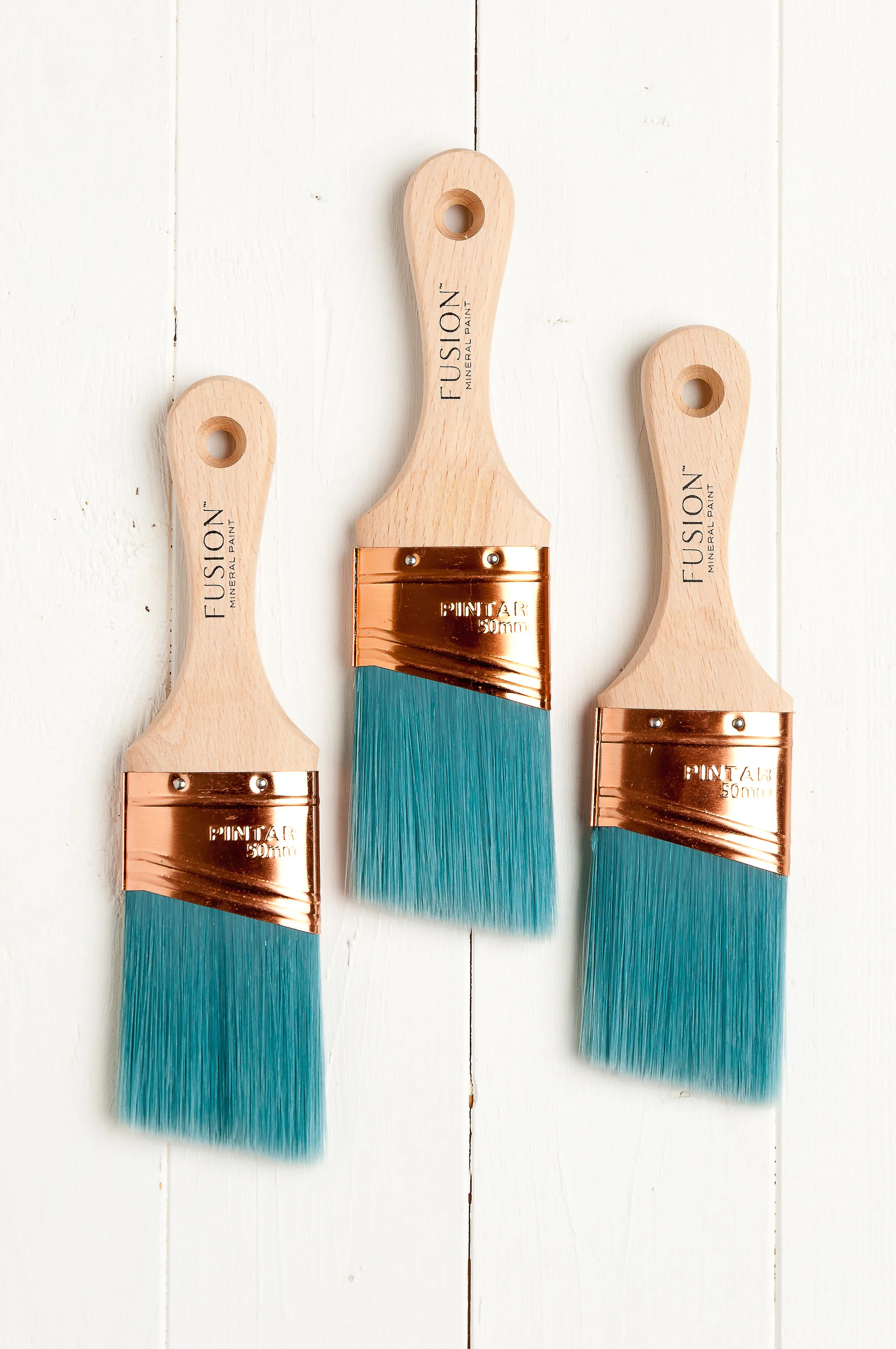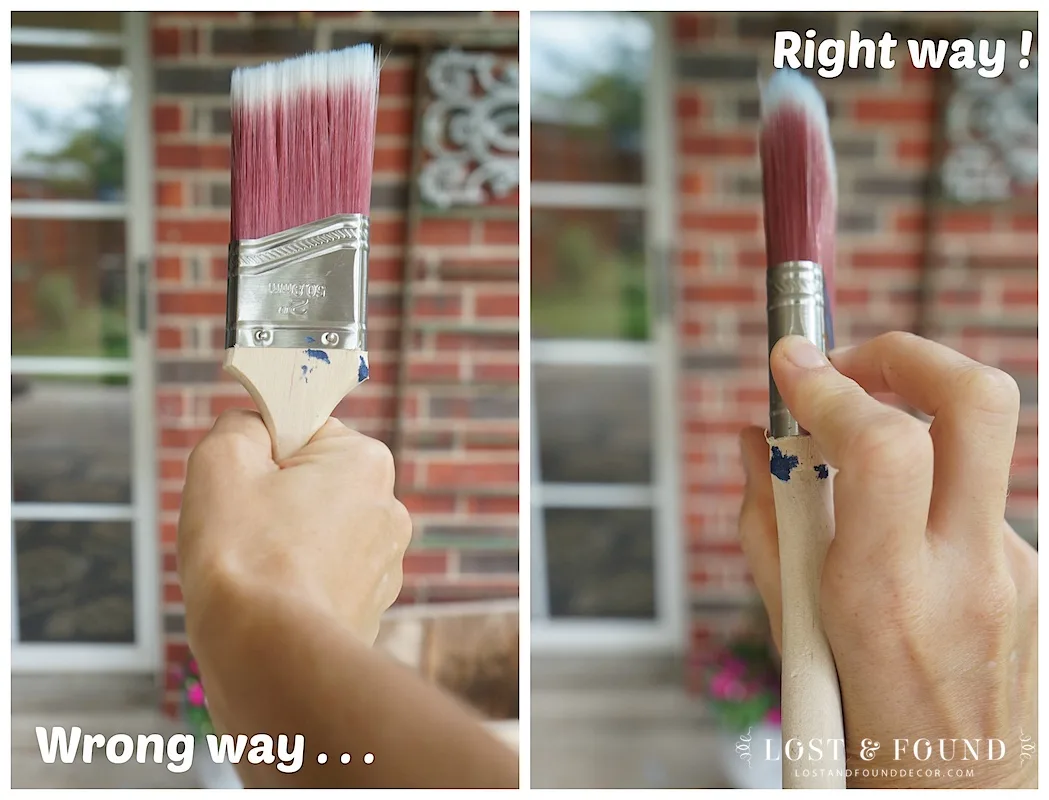“How do I get rid of brush strokes?”
That’s one of the most common questions I get from readers and customers!
Typically, as long as my finish is smooth, some light brush strokes don’t bother me much. But, when the brush strokes are really heavy and thick with texture, or when the paint finish is streaky and you can see obvious places where the brush started and stopped . . . Those issues can make a piece look messy!
So if you’ve been plagued by a messy paint finish in the past, I’ve got some tips today to help make sure your brush strokes are minimal and don’t distract from the smooth, professional finish of your piece.
1. Use the Right Brush for your Paint
To get a smooth finish you don’t have to use the best brush out there, but you do have to use a good one–and the right one for whichever paint you’re working with.
For milk paint, I recommend a synthetic bristle brush.
You can use an angled or a flat, whichever is your preference (I tend to prefer an angled), but the synthetic bristles are the key. Milk Paint has a very high water content and so if you use a natural bristle brush, the bristles will soak up too much water and your paint (and finish) will get thick and streaky.
For Fusion Mineral Paint or a chalk-type paint, I do prefer to use a rounded brush.

My favorite brushes by far for Fusion and chalk paint are the Staalmeester brand brushes.
These brushes are a combination of tightly packed synthetic and natural bristles. The synthetic bristles help your paint lay down smooth while the natural bristles help hold paint in your brush.
I do caution though against getting too much paint on your brush! Fusion and chalk-type paints look the best when painted in thin coats.
The biggest thing to remember about your brushes is to keep them clean and in good shape! Always wash them out immediately after use (thoroughly) with warm water and dish soap.
If you find that your brush is stiff after it dries, try Fusion’s Brush Soap. A soak overnight in a bit of this with a few teaspoons of water will get every last bit of paint out of your brush and leave it silky smooth! I also recommend drying your brushes by hanging them upside down and tying a string around your round bristle brushes to help them keep their shape.
If you are using an old brush and the bristles have gotten wiry and frayed, or are dirty with dried paint, it will not give you a nice smooth finish! Time to get a new brush, my dear.
2. Use Good Brush Technique
Once you have a good brush to use, practice holding it and working with it until you are comfortable. Don’t grab the brush with your whole fist, but rather grasp it similarly to how you hold a pencil.
When applying your paint, hold the brush at an angle to the piece, not straight up and down. It’s best also to gently lay down the paint with the brush and not push too hard onto your surface.
Another good trick is to try dipping the tip of your brush in a tad bit of water before you dip it into the paint. Keeping the tips of your bristles moist can help them be more pliable and gentle as they lay down the paint.
3. Paint in the Same Direction as the Wood Grain
This is especially important if you’re working with a wood that has heavy grain, like oak! As much as possible, you want to brush in the same direction that the grain runs. Brushing against the grain will create texture as the paint reacts to the natural texture of the wood.
If you’re painting a piece that the grain is not very deep or a smooth piece like a laminate, do your best to paint each section or area of the piece in only one direction. For example, if you’re painting the side piece of a dresser, don’t paint the top and bottom horizontally, then fill in the rest of the side with vertical strokes. Make sense?
4. Lightly sand in between each coat of paint and after the final coat
This is one of my simplest tips to offer if you want to better your painted finish!
After each coat of your paint dries, smooth it out by running fine grit sandpaper (at least 320) over the surface, then wipe with a damp cloth. Even if you can still see some brush strokes, this will help your piece feel nice and smooth.
If you’re painting with Fusion, you can try wet-sanding the final coat of paint for an ultra-smooth and soft finish!
5. Try Rolling On, Laying Off
If you’re wanting a super sleek, brush-stroke free surface, then I would suggest skipping a brush altogether!
I’ve had a lot of success using a microfiber roller with Fusion.
First, you use the roller to apply a thin coat of paint to an entire section of your piece, then very quickly, go back over the section with your flat synthetic brush and lay off the paint.
Laying off is really just a fancy term for dragging the tip of your brush super lightly over a rolled surface, from one end to another to smooth out any texture left by the roller.
I used this method when I painted my set of MCM dressers and the end result was fantastic! The finish was super smooth and had that modern, sleek look I was going for.
6. Give Yourself Some Grace!
Yes, this is my last tip for how to minimize brush strokes! I honestly think the furniture painting world has gotten a little too worked up about them recently and we’re losing out on some of the fun and creativity that comes from hand-painting a piece of furniture.
It’s important to understand that if you’re using a diy-type furniture paint (Fusion, Chalk-type paint) that those paints are not formulated to produce a super sleek, glass-smooth finish.
If you’re seeing pictures online of furniture pieces with a high gloss, factory-smooth finish, my bet is that the painter is using either oil-based or enamel paint along with possibly a paint sprayer. Those are the tools that you use to create those kinds of finishes.
Those pieces are stunning! But for most of us that’s not the look we are going to achieve using our diy furniture chalk-type paint–so don’t be so hard on yourself!
To be honest, I tend to not worry too much about brush strokes and more about the overall smoothness of my finish. If you look closely at my pieces, you will see some brush strokes! But I still believe they are well-painted, smooth, and professionally finished pieces.
So for those of you who are new to the furniture painting world and feel like your pieces have a lot of brush strokes, here’s my word to you–
Get a good brush.
Practice using it.
Try some of the techniques above.
Then step back and stop judging your piece so much!
As painters, we are always our own worst critics!
I hope this post has given you some ideas to try but also some freedom to know that if you’re using a brush, your piece doesn’t have to be glass-smooth to be painted well. The most important thing is to enjoy the process and work each time to get a little bit better at your craft.
Happy Painting!
Pin this Resource!














Mary
Saturday 18th of February 2023
Big Thank You to Melanine!
Very helpful guide and practical way to apply right way.
This made my first time painting experience interesting and gained more confidence. The rest will be practice, practice and practice!
Many Thanks, one more time!
Melanie Alexander
Monday 27th of February 2023
Yes! Practice really does make perfect!
5 Ways to Smooth Acrylic Paint Strokes to Avoid Streaks - Adventures with Art
Wednesday 8th of February 2023
[…] might have heard about sanding walls or furniture while painting (source), but the same applies with paintings too. You’ll just want to be more careful and […]
7 Best Paint Brushes for Oil Based Paint 2022 – PaintHackS
Tuesday 17th of January 2023
[…] Soft bristle tips and thus reduces brush marks. […]
DIY Guy
Friday 15th of December 2017
Really good tips - application is everything - beautiful pics!
Melanie
Friday 29th of December 2017
Thanks! I’m glad you found it helpful
DIY Guy
Friday 15th of December 2017
Really good tips - application is everything - beautiful pics!
Melanie
Friday 29th of December 2017
Thanks! I’m glad you found it helpful